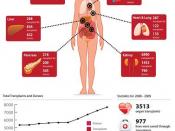Introduction Organ donation rates in Australia are still not large enough to meet the need of those on waiting lists for transplantations. Organ transplantations involve the support of an organ donor and a recipient. The organs are removed form the donor and placed into the recipient. This may seem a relative simple procedure but many complications and regulations take place. The blood group, body weight, age, length of time on the waiting list and build of the person must be considered. For organs to be donated the donor must be considered brain dead not circulatory dead. When circulatory death occurs the organs such as the heart and lung can not still function with the aid of a machine this makes them useless to the recipient This health issue in relation to the developing medical procedures that take place in Australia has been ongoing and is a re-emerging health issue. It is a national problem in all states of Australia this can be reflected by Tasmanian/Victorian statistics with three hundred and seventy six people waiting for transplantations and only thirty-four organ donors in these regions.
This problem needs to be addressed on a national perspective and has been discussed by a variety of pressure groups such as state and federal governments, churches and religious and individuals in today's society.
Nature of the issue and why did it arise The shortage of organ transplantations taking place in Australia has arose out of the simple problem that there are not enough organ donors. It takes many people to be directly involved or associated with a person waiting for a transplant before they even consider donating their organs. This is reflected in the following data: Summary of Donors by Year (per million population in brackets) January 2001 QLD NSW/ACT VIC/TAS SA/NT WA TOTAL 1994...


